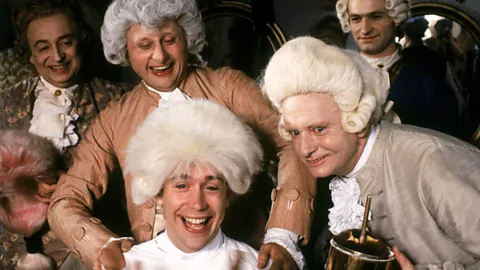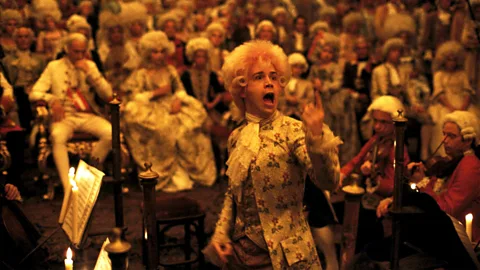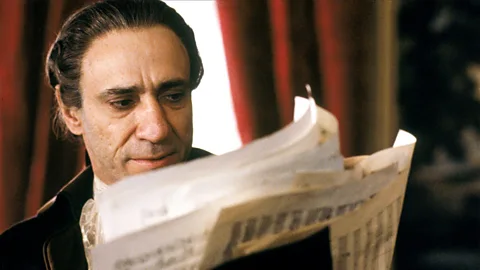 Alamy
AlamyReleased 40 years ago this month, Miloš Forman’s best picture-winning Amadeus is often accused of historical inaccuracies – but the film’s critics could be missing the point.
When it premiered 40 years ago, Amadeus drew an initial wave of praise. A historical drama revolving around the rivalry between two composers, Wolfgang Amadeus Mozart and Antonio Salieri, it went on to win eight Oscars, including for best picture. Miloš Forman took home the best director prize, Peter Shaffer won for best adapted screenplay and both of the lead actors were nominated: F Murray Abraham, who played Salieri, beat Tom Hulce, who played Mozart.
But in the years that followed, a backlash grew over what some people saw as Amadeus’s litany of historical errors. An article in The Guardian declared that “the fart jokes can’t conceal how laughably wrong this is”, and the BBC commented that “the film plays shamelessly fast and loose with historical fact”. Salieri, critics noted, was no pious bachelor (as attested by his wife, eight children and mistress), and it’s after all an odd kind of hateful rivalry when the real Mozart entrusted the musical education of his own son to Salieri. As for Mozart’s lewd humor, that cheeky insouciance was actually commonplace in middle-class Viennese society. Most egregiously of all, world-famous Mozart was not dumped in an unmarked pauper’s grave. If this is a homage to history, the complaint goes, it’s akin to Emperor Joseph II fumbling ineptly on the pianoforte and bungling every other note.
But this kind of cavilling may be missing the point. Forman’s aim for Amadeus can be seen as radically different from a typical biopic, and that was to use a fictionalised version of an epic clash between musical composers to allegorise the defining global rivalry of the mid-to-late 20th Century: the Cold War. Put simply, the film may have played fast and loose with 1784 because its real preoccupation was 1984.
The film opens in Vienna in 1823. Grizzled court composer Salieri howls through a bolted chamber door that he has murdered Mozart, then slashes his own throat. Days later, as he convalesces in an asylum, a priest arrives to hear his confession. It doesn’t disappoint. Salieri recounts that as boy he made a vow of chastity to God as an expression of gratitude for, as he sees it, ushering in the providential death of his father to clear the path for his musical development.
Jump ahead some years, and Salieri is now an eminent composer in the court of Joseph II (Jeffrey Jones), where he eagerly awaits an introduction to musical prodigy Mozart. That eagerness curdles when he sees the man in the flesh – he turns out to be a lascivious vulgarian with an ear-splitting cackle. Convinced that God means to mock his own mediocrity, Salieri hurls a crucifix in the fire and vows retaliation. When Mozart’s father dies, Salieri seizes on the misfortune with a dastardly stratagem: dupe Mozart into believing that his father has risen from the grave to commission him to write a requiem, then murder him and pass off the masterpiece as his own. Mozart, feverish and besotted with drink, dies, leaving Salieri addled with bitterness and destined for obscurity.
 Alamy
AlamyThe premise wasn’t original to Forman. Drawing inspiration from Alexander Pushkin’s taut 1830 play Mozart and Salieri, Peter Shaffer wrote a highly stylised play called Amadeus, which premiered in London in 1979. Forman, sitting in on a preview, was entranced by the dramatic rivalry and convinced Shaffer to collaborate with him, not merely to adapt the play for the screen but to “demolish the original, then totally reimagine it as a film”. Across four irascible months cloistered in a Connecticut farmhouse with Shaffer, Forman fundamentally rebuilt the narrative with a fresh palette of political resonances.
The casting process for the coveted roles of Mozart and Salieri rivaled Gone with the Wind in scope and behind-the-scenes intrigue, all of which played out over a year and involved meetings with literally thousands of actors. Kenneth Branagh was nearly victorious in landing Mozart, then got dropped from consideration when Forman pivoted to a US cast. Mark Hamill endured grueling hours of auditions, only to be told by Forman: “No one is believing that the Luke Skywalker is the Mozart.” Al Pacino lobbied hard for the part of Salieri, in competition with Mick Jagger, Burt Reynolds, Donald Sutherland and Sam Waterson. In the end, Forman eschewed splashy celebrities for Hulce and Abraham, only to have casting drama explode again when Meg Tilly, slated to play Mozart’s wife, Constanze, broke her ankle playing football: she was replaced by Elizabeth Berridge a week before shooting was to commence. With the plot rebuilt and the cast in place, more than one rivalry was poised to come into focus.
The triumph of genius
The Czech-born Forman had been a galvanising force behind the Czechoslovakian New Wave film movement in the 1960s, reaching a climax with his 1967 film The Firemen’s Ball, which satirised the absurd inefficiencies of Eastern European communism. The film was initially warmly received within the reformist milieu of the Prague Spring, but when Soviet tanks rolled into Prague the following year and organised Czechoslovakia into the Eastern bloc, Forman, tarred as a “traitor” to the state, was forced to flee to the West and found refuge in the US.
Nearly all of Forman’s film work thereafter would show glimmers of opposition to Soviet-style censorship, confinement, and concentrated power. His first success in the US, for example, 1975’s One Flew Over the Cuckoo’s Nest, depicted a mental health ward meting out cruelty and coercion to patients under the guise of benevolent care. Audiences barely needed to squint to see the asylum as gulag and Nurse Ratched as the embodiment of the drunk-on-power Soviet bureaucrat. Likewise, Forman’s 1996 film, The People vs Larry Flynt, depicted the founder of Hustler magazine squaring off against censorship at the cost of being jailed, locked up at a psychiatric facility and paralysed by an assassin’s bullet.
 Alamy
AlamyThe Soviet allegory can certainly be applied to Amadeus. Perhaps Forman was less concerned with hewing to biographical facts as he was with presenting Mozart as a beleaguered type of ecstatic genius who, hostage to patronage, is stifled and finally crushed by the repressive apparatus of the state. Joseph II, absolute ruler of the Habsburg monarchy, is advised at court by a clutch of prudish sycophants who undermine Mozart’s achievements and smear his reputation. Whatever its loose correspondence to the late-18th and early-19th Centuries, this critique can be read as a stab at the USSR – a debilitatingly centralised bureaucracy hostile to insurgent ideas and innovation. But Forman showed that Mozart would get the last laugh. By the events of 1823, Salieri’s insipid, state-sponsored melodies have all been forgotten, while a few bars of Mozart draw immediate joy to the priest’s face. In the free market of popular tastes, Salieri’s mandated drivel has been suffocated by the triumph of genius.
In Forman’s hands, the Habsburg Empire bears the hallmarks of Soviet power. The masquerade balls, with their bewildering swirl of masked identities, conjure the confusion and paranoia that proliferated under the Soviet system. Salieri’s reluctant servant-spy (Cynthia Nixon) carries out covert surveillance, a nod to the 20th Century’s KGB, which had thousands of its moles burrow into the private lives of artists and dissidents. Meanwhile, Salieri’s heretical burning of the crucifix and war on God call to mind the ideological struggle between a Christian worldview and secular Soviet hubris. (After Abraham’s mother – a pious Italian woman – saw the cross-burning scene, she browbeat her son so relentlessly that he blurted out what he now tells the BBC was a lie: “I told her, ‘mum, that was an extra – somebody else threw it in there!'”)
And then there’s the mass grave into which Mozart’s corpse is dumped. This depiction does not fit the facts of what is known about his death, but it makes sense if read as an indictment of Soviet practices – the effacement of individual identity and literal mass murder. Grim excavations of these pits continue to this day. Forman, whose own parents perished in Nazi concentration camps, understood the power of this imagery.
 Alamy
AlamyJeff Smith, author of Film Criticism, the Cold War, and the Blacklist, tells the BBC that Mozart’s struggle against the status quo tapped into Forman’s own frustrations with Soviet censorship. “The emperor’s fatuous judgment about Mozart’s opera – ‘too many notes’ – is just the kind of accusation that was used as a cudgel used against avant-garde artists and thinkers to imply their work isn’t pleasant or edifying to Soviet ears. Mozart’s enraged incredulity in that scene must have mirrored Forman’s own longstanding contempt for Soviet stagnation and repression.”
Amadeus behind the Iron Curtain
Shooting took place in 1983 over a six-month period in Prague, which had the virtue of offering basilicas, palaces and cobblestone squares virtually unchanged since the late 18th Century. Even with Soviet power waning, however, Czechoslovakia remained part of the Eastern bloc and Forman was still persona non grata, so a deal was struck: the director would refrain from meeting with political dissidents, and the regime would allow friends of Forman to visit with their repatriated prodigal son.
Forman’s own recollections from the shoot centred on the travails of Soviet interference. His landlady warned his phone is bugged. Informers lurked in every room. Two unmarked cars tailed him everywhere, which seemed redundant since his own driver was also a secret agent. In his autobiography, Turnaround, Forman is just shy of explicit about the degree to which themes of Soviet repression leaked into Amadeus. “As it had to be in the socialist Prague,” he wrote, “the spirit of Franz Kafka presided over our production”.
Perhaps even more telling is a story he recounts of negotiating with the general director of Czechoslovak film, Jiří Purš, who, as Forman recounted, wanted absolute assurance that the Communist Party would have nothing to fear: “I assume that politically there is nothing in the script that they could hang their hats on?” Forman’s reply is a model of plausible deniability and acid irony: “Look, it’s about Mozart!”
F Murray Abraham felt the strain of coercive scrutiny as he was traveling back and forth to the United States to shoot his role in Scarface (1983) while Amadeus was in production in Prague.
Abraham tells the BBC, “At the end of every shooting day I had to cross the border to get to the airport in Vienna to return to Hollywood. At the checkpoint, the Czechoslovak Police would make us sit idle at the gate, just as a way to throw their weight around, make you know who’s in charge. That sense of bullying and intimidation was everywhere, and even when the Czech people responded with subversive humor, the strain was palpable. We never forgot for a minute that we were under communist surveillance.”
That tension between the US crew and Soviet agents finally burst out into the open on 4 July. The production was shooting an opera scene, and the crew arranged so that when Forman yelled “action” a US flag unfurled and the national anthem played in lieu of Mozart’s music. Some 500 Czech extras burst forth into emotional song, in effect revealing their sympathies with the West. But not all of them.
Forman recalled, “All stood up – except 30 men and women, panic on their face, looking at each other [asking] what they should do. They were the secret police, dispersed among the extras.”
 Alamy
AlamyAs Amadeus continues to be reassessed at its 40th anniversary, the significance of the Cold War looms ever larger. Paul Frazier, author of The Cold War on Film, tells the BBC that the film brilliantly tapped into a deep vein of Soviet envy: “Salieri is the Soviet Lada trying to be a Ford Mustang. He can’t be as great as Mozart, so he resorts to undermining and manipulating him. This too was the approach of the old USSR towards the West: rather than being better than the West, the Soviets resorted to undermining and discrediting the West at every turn.”
Historian Nicholas J Cull echoes that analysis. “Think of the Jonathan Swift line: ‘When a true genius appears in the world, you may know him by this sign, that the dunces are all in confederacy against him.’ Whether it’s the 1780s or 1980s, what you have is true genius facing off against mediocre, conniving bureaucrats. You see this same dynamic at play in a Cold War film like last summer’s Oppenheimer, which in some ways is Amadeus with A-bombs. It makes sense that refugee film-makers like Forman and his creative team would be drawn to tell an allegory of communist mismanagement.”
Not everyone is sold on the idea that Amadeus wrestles with Soviet totalitarianism. Kevin Hagopian, a media studies professor at Penn State University, says there’s a risk of allegorising everything as an unseen Soviet menace, which ends up making art a mere handmaid to politics.
“That ultimately becomes a depressingly narrow way to appreciate the dazzling beauty and emotional breadth of Mozart’s music,” Hagopian tells the BBC. Nevertheless, he adds, we can’t ignore the political resonances.
“The allegorical space that satirical Czech film-makers like Forman opened up meant that audiences began to look for, even perhaps invent, allegorical political meaning,” he says. “All films could be read against the grain of a regime that lacked not only humanity but any sense of irony about itself. So if Amadeus wasn’t really about Soviet-style tyranny, but audiences merely thought it was, well, I have a feeling that would be just fine with Miloš Forman.”
For his part, Abraham is candid about what he believes are the more contemporary political stakes of the film, as he told the BBC in June. “Think about how many Americans now idolise Putin. These autocrats are suddenly celebrated again. It’s disheartening, truly demoralising, but if Amadeus can help us see our current predicament through fresh eyes, that shows you how powerfully its message still resonates.”
Source: BBC Culture – www.bbc.com





